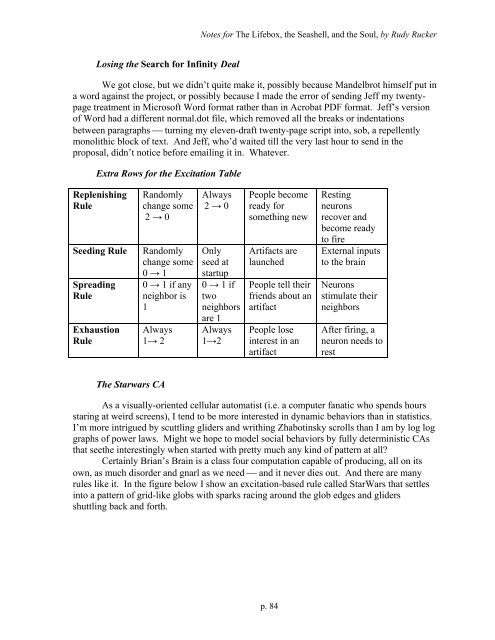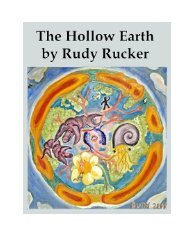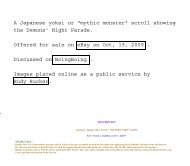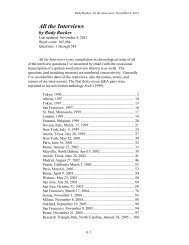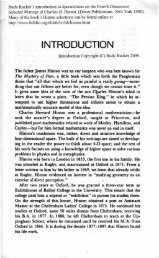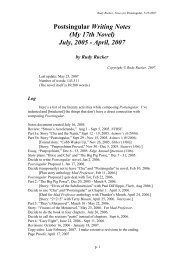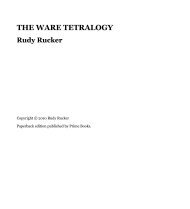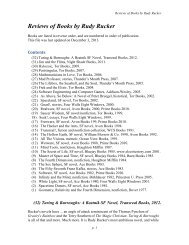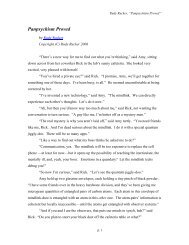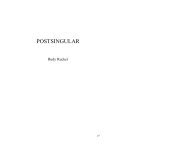Notes for the Lifebox, the Seashell, and the Soul - Rudy Rucker
Notes for the Lifebox, the Seashell, and the Soul - Rudy Rucker
Notes for the Lifebox, the Seashell, and the Soul - Rudy Rucker
You also want an ePaper? Increase the reach of your titles
YUMPU automatically turns print PDFs into web optimized ePapers that Google loves.
<strong>Notes</strong> <strong>for</strong> The <strong>Lifebox</strong>, <strong>the</strong> <strong>Seashell</strong>, <strong>and</strong> <strong>the</strong> <strong>Soul</strong>, by <strong>Rudy</strong> <strong>Rucker</strong><br />
Losing <strong>the</strong> Search <strong>for</strong> Infinity Deal<br />
We got close, but we didn’t quite make it, possibly because M<strong>and</strong>elbrot himself put in<br />
a word against <strong>the</strong> project, or possibly because I made <strong>the</strong> error of sending Jeff my twentypage<br />
treatment in Microsoft Word <strong>for</strong>mat ra<strong>the</strong>r than in Acrobat PDF <strong>for</strong>mat. Jeff’s version<br />
of Word had a different normal.dot file, which removed all <strong>the</strong> breaks or indentations<br />
between paragraphs ⎯ turning my eleven-draft twenty-page script into, sob, a repellently<br />
monolithic block of text. And Jeff, who’d waited till <strong>the</strong> very last hour to send in <strong>the</strong><br />
proposal, didn’t notice be<strong>for</strong>e emailing it in. Whatever.<br />
Extra Rows <strong>for</strong> <strong>the</strong> Excitation Table<br />
Replenishing<br />
Rule<br />
Seeding Rule<br />
Spreading<br />
Rule<br />
Exhaustion<br />
Rule<br />
R<strong>and</strong>omly<br />
change some<br />
2 → 0<br />
R<strong>and</strong>omly<br />
change some<br />
0 → 1<br />
0 → 1 if any<br />
neighbor is<br />
1<br />
Always<br />
1→ 2<br />
Always<br />
2 → 0<br />
Only<br />
seed at<br />
startup<br />
0 → 1 if<br />
two<br />
neighbors<br />
are 1<br />
Always<br />
1→2<br />
People become<br />
ready <strong>for</strong><br />
something new<br />
Artifacts are<br />
launched<br />
People tell <strong>the</strong>ir<br />
friends about an<br />
artifact<br />
People lose<br />
interest in an<br />
artifact<br />
Resting<br />
neurons<br />
recover <strong>and</strong><br />
become ready<br />
to fire<br />
External inputs<br />
to <strong>the</strong> brain<br />
Neurons<br />
stimulate <strong>the</strong>ir<br />
neighbors<br />
After firing, a<br />
neuron needs to<br />
rest<br />
The Starwars CA<br />
As a visually-oriented cellular automatist (i.e. a computer fanatic who spends hours<br />
staring at weird screens), I tend to be more interested in dynamic behaviors than in statistics.<br />
I’m more intrigued by scuttling gliders <strong>and</strong> writhing Zhabotinsky scrolls than I am by log log<br />
graphs of power laws. Might we hope to model social behaviors by fully deterministic CAs<br />
that see<strong>the</strong> interestingly when started with pretty much any kind of pattern at all?<br />
Certainly Brian’s Brain is a class four computation capable of producing, all on its<br />
own, as much disorder <strong>and</strong> gnarl as we need ⎯ <strong>and</strong> it never dies out. And <strong>the</strong>re are many<br />
rules like it. In <strong>the</strong> figure below I show an excitation-based rule called StarWars that settles<br />
into a pattern of grid-like globs with sparks racing around <strong>the</strong> glob edges <strong>and</strong> gliders<br />
shuttling back <strong>and</strong> <strong>for</strong>th.<br />
p. 84


